Since moving to Austin 10 years ago, I have been constantly dismayed at the way statistics and other data have been used to characterize our community.
If we are to believe popular perceptions, Austin is poor, crime-ridden and riddled with foreclosures, and if you were to visit here, you would likely be shot.
However, a stroll around most parts of Austin shows the truth is far from this — and proper analysis of the data supports this alternate story.
Many parts of our community are solidly middle class and as safe as neighborhoods widely considered to be “good” ones. Although foreclosures are certainly a serious problem in some parts of Austin, many other communities have been hit far harder.
The constant mischaracterization of Austin is hindering development and investment in our community. The problem stems in part from the fact that Austin is too big compared to other official Chicago Community Areas or CAs.
Why is being so big a problem? Usually CA-comparative statistics are presented as sheer-number-per-community-area figures, and not manipulated per capita, per square mile, or some other relevant and necessary analytical criteria.
With sheer-number comparisons, the biggest area almost always jumps to the top of the list, no matter what is being analyzed.
There are other flaws with the CAs, which were created as an experiment, drafted by student interns who were overseen by a poorly paid research assistant, and are no longer in keeping with the original spirit or intent.
So why are we even still using them, especially when a mostly decent neighborhood like Austin, full of potential and scarred by media misrepresentations and stereotypes, keeps getting victimized by the misuse of sheer-number-per-community-area data?
Government agencies, not-for-profit foundations, industry groups and the media either need to stop comparing city statistics by CAs, or Austin should be split into smaller units.
Of Chicago’s 77 CAs, Austin has for several decades ranked as the largest by population (98, 514 according to the 2010 census).
If Austin were its own city, its population would be the 9th largest in Illinois — between Elgin at 107,163 and Waukegan at 94,277 – and nearly as large as the state capital Springfield at 116,250. Austin alone comprises almost 1 percent of the state’s entire population.
Austin is the third largest CA in terms of geographical size.
Only O’Hare and South Deering are bigger, and both have enormous swaths of uninhabitable space – O’Hare has one of the largest airports in the world, and South Deering houses Lake Calumet, giant rail yards and abandoned industrial sites. Yet O’Hare and South Deering’s populations pale by comparison with Austin, at 12,756 and 15,109 respectively.
Top Ten CAs by Population and Geographical Size

While Austin is disproportionately large, other CAs are excessively small. Fuller Park, one of the smallest CAs, has just 2,876 people and measures only 0.7 square miles. In an area this small, even if incredibly crime-ridden, there will be one or two homicides a year if that.
It is ludicrous to compare tiny areas to giant ones. The CAs do not just compare apples to oranges, they compare blueberries to melons!
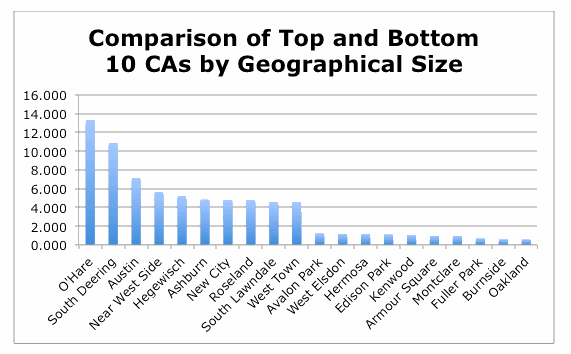
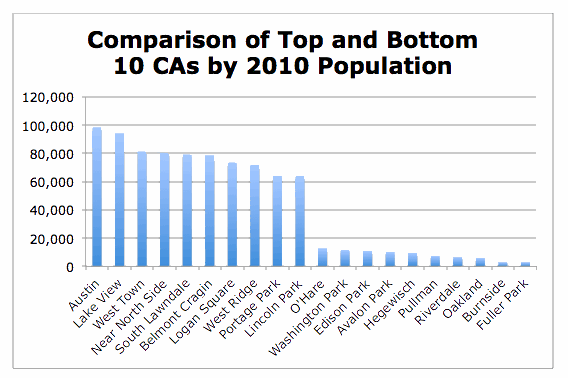
Austin’s population was also large back in 1930, the first year census data was actively applied to the new community-area designations. But it has transformed far less than other CAs.
The population range across all CAs in 1930 went from 187,292 (West Town) to just 733 (Ashburn); in 2010, this range had narrowed to 98,514 (Austin) to 2,876 (Fuller Park). Comparing this data from 1930 to today, one might posit that Austin looks fairly stable!
The chart below makes the oft-cited comparisons between Austin and the two Englewoods, as the Chicago Tribune did in a recent story, even more egregious. Compared to its 1930 top-ten-population neighbors, Austin had the second lowest percentage population change between then and today.
I wonder: might it be more accurate to compare Austin to Lakeview, Lincoln Park and Logan Square?
Top Ten CAs by 1930 Population, Ranking Today, and Percentage Decline
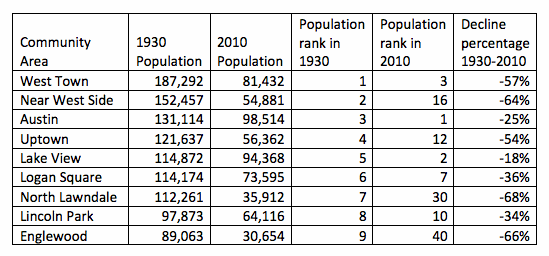
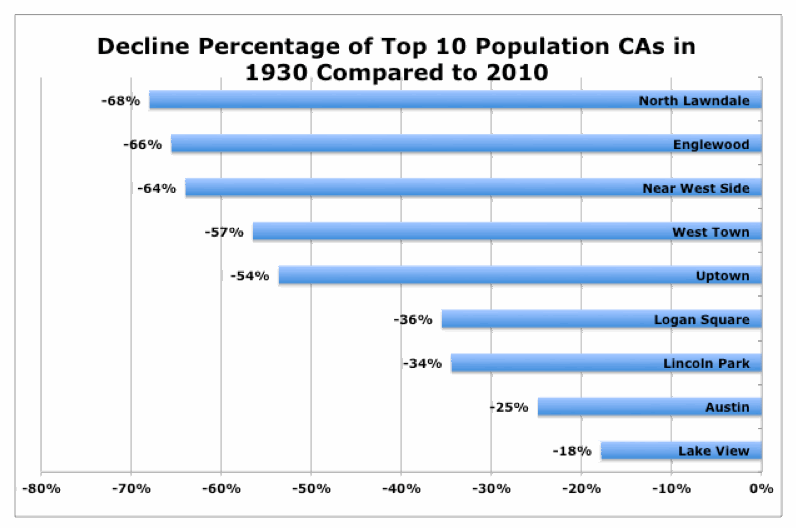
In doing research about how the CAs emerged, the most fascinating fact (and one that still floors me, given how ubiquitous and important they have become) is that they were considered to be an experiment when created in 1929.
Scholars affiliated with the Local Community Research Committee (LCRC), a subset of the University of Chicago Social Science Research Committee, considered Chicago to be a “laboratory” for their research and the creation of the CAs to be part of a “controlled experiment.”
They sought to define the boundaries of community areas in Chicago partially by considering uniting characteristics.
Modeled after a similar project just implemented in New York City, the LCRC rationale for the creation of the CAs as research units made some sense — the census statistics as a whole for the entire city of Chicago were too broad to be meaningful. Individual census tracts were not static over time, often had been created arbitrarily and did not yield data that could be consistently applied to investigations of specific social groups.
Originally, the committee devised 80 CAs, then revised the number down to 75 for the final 1929 map. A few of the areas that did not make the final cut were Sheldon Heights (part of Roseland), Slag Valley (part of South Deering) and South Pole (also part of South Deering).
The CAs have indeed remained relatively static over nearly a century. Only two changes have been made. The O’Hare area (CA 76) was added after that land was annexed to the city in the late 1950s. In 1980, Edgewater (CA 77) successfully petitioned to secede from Uptown.
Is it time for Austin to campaign for a similar division into smaller areas?
1929 Chicago Community Area Map

[Note: you can compare this historical map with the City of Chicago’s current map here.]
Most problematic is the notion of ecological areas as determining community boundaries.
Vast portions of neighborhoods were demolished through eminent domain to build interstates, which were absent in the 1920s when the CAs were created. Rail, elevated and street care lines have been constructed and deconstructed. So many industries that once served as the foundations for various CAs have since declined.
These factors have altered Chicago’s “ecological” boundaries substantially, not to mention have had a psychological impact on the people who inhabited neighboring land.
Additionally problematic is the secession of Edgewater. Why would Galewood, the Island, Henry Austin’s original 1865 “Austinville” (470 acres bounded by Austin, Laramie, Madison and Chicago), or even just North Austin and South Austin not similarly be candidates for their own CA assignations?
Finally, the use to which the CA’s have been put in recent decades strays far from the original conception of the experimental project.
The committee designated the various areas primarily to investigate social dynamics within each area, not necessarily to compare one area to another using blanket comparisons, and certainly not to rank the areas by some particular unprocessed or improperly analyzed bit of quantitative data to create artificial hierarchies.
The sociologists who created the CAs would be rolling over in their graves if they knew how the sheer-number data was being deployed in the media and by non-profit, governmental and industry groups (especially those in real estate) to characterize Austin, and even worse to pit it against other areas of Chicago.
Just because something is “fact” doesn’t mean that it is automatically reportable information — facts need to be properly analyzed. The role of ethical journalism, research and scholarship is to present information, not mere facts, which can be misleading at best and dangerous or harmful at worst.
For its intended purpose — tracking area change over time — Austin as a community area presents a fascinating case study.
I wonder what the LCRC researchers would have to say about the incredible (and incredibly rapid) social and/or economic transformations in Austin that started in the mid 1960s, and how much they sometimes varied from one part of Austin to another?
For certain criteria (like race), demographics have shifted enormously from the late 1920s when the initial data was compiled. But the housing stock and population density have remained about the same. Some areas of Austin, aside from racial change, seem to have had little transformation (something I hope to research further).
A note to readers: If some reported statistic about Austin has jumped out at you as odd, please alert us at AustinTalks. The author would be happy to look at the data and report back. Anna Friedman Herlihy teaches at the University of Chicago and the School of the Art Institute of Chicago, and is completing her PhD in history of culture at UC.
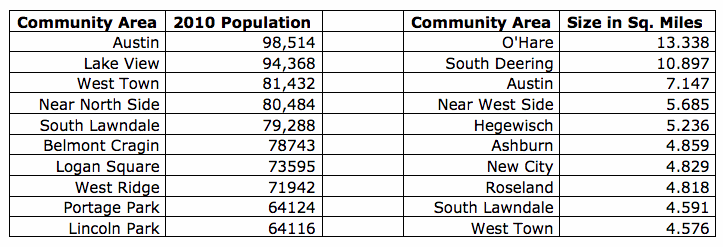
This is an incredible article! Thank you so much for all the facts and research you did for this. I live in Austin and more often than not when I mention the area people in other areas of Chicago either have never heard of it or think that if they venture into it they will be shot or at least be the victim to some random violent crime. When people then come visit me they are always surprised by the area, the size of the houses and the yards and how clean it is on some blocks. Don’t get me wrong there is a fair share of crime around my house but for the most part if you are not part of gang you are left alone.
Again, thanks for all the great statistics you did an amazing job on this article.
I agree with everything Linda said!
My friend and I were just talking about this very subject, so it’s a pleasant surprise to see an article about it on here. When telling people that I live in Austin, most non-Austin residents insinuate that it’s dangerous, violent, poor, etc. And yes, those parts exist, but the neighborhood is so diverse that it’s unfair to categorize the whole thing as one thing. Anyway, thanks for the great article!
This is a great article. I have been studying the CAs extensively, both their history and their transformation, in hopes of buying a house somewhere in Chicago. Austin always stands out to me from the rest–it has its share of big houses, wide lots, tree-lined streets, and beautiful buildings. I drove through the area recently to check out a few houses I saw online and did not feel uncomfortable to the degree that I had predicted. I would love to see the area of Austin come back and shed the stigma its name has obtained. Of course, this is no gradual process and something that might not happen on its own. Some larger force, like the separation or dissection of the large Austin CA, as the article alludes, might provide this stimulus. This is a great topic to be thinking about!